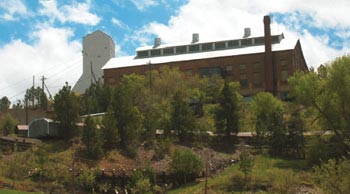A new frontier in experimental science was crossed in October when the state of South Dakota committed $20 million to pave the way for its acquisition and conversion of the Homestake Mine into a multidisciplinary underground laboratory, which it will operate until at least 2012. This boost from the state also aids longer-term planning, helping to position Homestake as a possible home for the proposed Deep Underground Science and Engineering Laboratory (DUSEL). The transfer of the property is scheduled to take place on 15 December.

The 125 year-old Homestake Mine, which was once the largest goldmine in the western hemisphere, is the deepest in North America, reaching 2500 m below ground. It became well known as the site of the first solar-neutrino experiment, which ran continuously from 1967 to 1994 and earned Raymond Davis the Nobel Prize in Physics in 2002. In May 2004 the company that owned the mine announced that it would turn off the pumps that prevent the mine from flooding.
The state of South Dakota’s funding will re-establish access into the mine, pump out the accumulated water and establish an operating laboratory at the 1500 m level, where Davis’s experiment was located. The lower levels will be developed in later years. Experimental Letters of Interest for short- and long-term experiments are now being solicited from the international community. The first experiments are scheduled to begin in 2007.
These depths provide the low-background environment needed to conduct a spectrum of physics experiments including studies of neutrinoless double beta decay and dark-matter searches. With more than 500 km of tunnels, the mine provides safe access to various depths, can accommodate large detectors, and offers expandable spaces to sustain evolving experiments over decades.
Homestake is one of two finalists selected by the National Science Foundation (NSF) for the location of a future DUSEL; the other site is Henderson Mine in Colorado. Both proposals have received grants of $500,000 from the NSF to develop conceptual design reports. The site for DUSEL should be chosen in late 2006.
For the first time, a single site dedicated to science will house an array of experiments spanning the disciplines of particle and nuclear physics, geology, hydrology, engineering, geomicrobiology and biochemistry. Forty years after Davis installed his solar-neutrino detector at Homestake, a new generation of experimentalists will avail themselves of the same site for this spectrum of modern-era experiments. As DUSEL is developed in the coming years these experiments will delve even deeper underground in a quest to answer some of the greatest scientific mysteries of our time – from dark matter, neutrinos and nucleosynthesis to probing the limits of life.
Physics, astrophysics and earth sciences are anticipated to be among the first disciplines to establish experiments. As well as experiments on neutrinoless double beta decay and searches for relic dark matter, large detectors will study proton decay and be used for long-baseline neutrino experiments, ultimately to probe neutrino mass, hierarchy and possible leptonic CP violations.
The diverse geology at Homestake, with the existing deep drifts and boreholes, will be an equally big boon for earth scientists. For the first time, they will have access to more than 34 km3 of the Earth’s crust to study the subterranean environment. Geomicrobiologists will investigate the genome and the limits of life in extreme environments; hydrologists will study fluid flows through rocks; geochemists will explore the formation of minerals; and at the intersection of physics and geology, scientists will measure geoneutrinos emanating from the Earth’s crust.
The Homestake project is a partnership between the scientific community and the South Dakota Science and Technology Authority, which will oversee the conversion and manage the mine. The scientific team is headed by Kevin Lesko of Lawrence Berkeley National Laboratory and the University of California at Berkeley. The early implementation plan will create an operational facility in advance of the NSF selection process and be the basis of Homestake’s staged approach to creating DUSEL.
• For further information see http://neutrino.
lbl.gov/Homestake/LOI.







